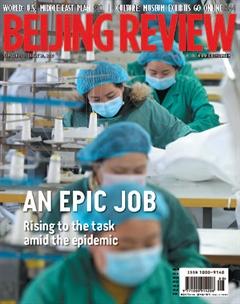TOOLS FOR RECOVERY
By Lan Xinzhen
Does the novel coronavirus outbreak mean economic opportunities for the U.S. that wouldnt have been possible under normal circumstances? Some U.S. media and officials seem to hold that unkind hope. However, it is unlikely as the impact of the virus on Chinas economy will be temporary and limited.
Economic opportunities should be seized by fair competition. The U.S., whenever it loses chances in international economic activities due to reasons of its own making, tends to blame others. It has blamed Japan, the EU and especially China, after the latters rapid economic growth, to the extent of slandering it and starting a trade war. Now with China engaged in fi ghting an epidemic, some in the U.S. pin their hope on extracting economic mileage from the virus.
They forget the H1N1 influenza outbreak in the U.S. in 2009 that was declared a public health emergency of international concern with a 17.4-percent mortality rate. The fatality incidence of the pandemic was eight times higher than the novel coronavirus. The ongoing flu season in the U.S. had affected 19 million people, with at least 10,000 deaths from September 2019 to the end of January, according to the U.S. Centers for Disease Control and Prevention. However, neither epidemic made the U.S. economy crumble. Given the strong resilience of the Chinese economy, the current challenge will not hinder its future growth either.
China has its own advantages, which have laid a solid foundation for its economic growth despite criticism of the Chinese system by the U.S. media and certain politicians. This system has powered China to mobilize all sections of society to fi ght the epidemic in accordance with international practices. China is following an integrated approach combining domestic and international methods and forces. Unfortunately, many U.S. politicians are unable to recognize Chinas huge potential.
The Chinese financial system has matured with the ability to cope with economic uncertainties and risks, a reason why the outbreak will not affect the economy in the long term. Having withstood the 1997 Asian financial crisis and the 2008 global fi nancial crisis, the country has established a sound response mechanism. With over $3 trillion in foreign exchange reserves, a low fi scal defi cit and a stable debt level, it can tackle any unexpected situation.
Chinas industrial structure has been upgraded, with equipment and hi-tech manufacturing taking the lead, while emerging industries and new forms of business have been rapidly developed. In 2019, for example, the value-added industrial output expanded 5.7 percent year on year, and production in strategic emerging industries increased 8.4 percent. The output of new products, such as urban rail vehicles and solar cells, rose 32.6 percent and 26.8 percent, respectively, year on year.
In addition, China has a well-developed logistics industry and highway, railway and shipping networks with a fairly comprehensive industrial system. These will help stabilize and maintain its manufacturing advantages.
So which enterprises are moving their factories back to the U.S. because of the outbreak, as U.S. Commerce Secretary Wilbur Ross anticipated? Well, none so far.
The seven-day Spring Festival holiday and the National Day holiday week in October every year mark the peak seasons for the tourism, catering, entertainment and other service sectors in China. The outbreak affected consumption during one of the two most important holidays, which will certainly have some fallout. The restrictions by some countries on Chinese goods and travel will also have an impact on Chinas imports and exports and lead to a decline in the economic growth in the fi rst quarter.
However, the government has already rolled out measures to stabilize the economy. The central bank has released 1.7 trillion yuan ($233 billion) to maintain adequate liquidity in the banking system during epidemic control. Countercyclical adjustments will be boosted to keep market liquidity at a reasonable and ample level. So far, the fi nancial market has been running smoothly.
On February 1, the central bank and four other authorities—the Ministry of Finance, the China Banking and Insurance Regulatory Commission, the China Securities Regulatory Commission and the State Administration of Foreign Exchange—jointly issued 30 measures to increase financial support for small and micro businesses, private enterprises, manufacturing and other key sectors. The central bank has also provided relending funds of 300 billion yuan ($42.97 billion) to national and local banks in the worsthit regions so that they can offer loans at discounted interest rates to key manufacturers of medical supplies and daily necessities.
In 2003, Chinas economy declined in the second quarter due to the severe acute respiratory syndrome. But then it rebounded with an annual economic growth rate of 9.1 percent. Similarly, while the current outbreak will affect economic growth temporarily, once the epidemic is under control, the economy will return to stable growth, and the consumption and investment disturbed by the virus will rebound, leading to economic recovery.

